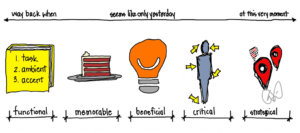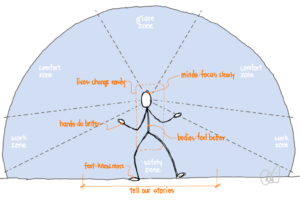I do not like messy things. You might not believe me based on the usual state of my desktop, but disorganization and messes slowly sap my strength. A freshly organized and cleaned desk invigorates. My team never sees my desk, as we are a distributed workforce (also known as work-from-home or remote workers), but they see my fanaticism nearly every day in the form of meticulously crafted slide presentations. I do not like disorder, for better or worse (yes, I wish I was more tolerant of messy stuff…I am a work in progress).
You can imagine my concern, then, when I approached the end of my 2023 Light Can Help Us series and found myself with a whole bunch of new ideas, terms, and strategies. Yikes. I had two choices, given my propensity for clarity: discard some of my hard-earned language of light or find a way to clean it all up.
For a while I worried that I would need to throw away my six promises of light. The new concept of lighting zones, based on human vision and biology, seemed simpler, easier to communicate, clearer, and that is the whole point of this exercise. So why not abandon the old language of promises and focus entirely on zones?
Well, for one, I discovered that my reluctance to trash the old promises of light was perhaps because there was nothing wrong with them. Learning more about light does not necessarily mean that what you learned before is wrong.

I found myself doodling more than usual, trying out different arrangements, writing new statements, sketching new diagrams. When I zoomed out and looked at the mess, a pattern of evolution appeared, revealing my life’s journey with light (so far, at least). Each stage, each step, was a new lesson that built on the previous phase. I would not be where I am today, in other words, without following the path that now trails behind me.
Way back when, which for me is around the year 2000, I learned a functional language of light that made it easy for me to get started on a career in lighting design. Task, ambient, and accent layers of light were more than a practice, they comprised a pseudo-religion that I followed devoutly.
I realized that these functional terms were useful to me, but not particularly engaging or memorable for clients, architects, interior designers, or my university students, and I began a search for an easier form of communication. It must have been November when I created the Red Velvet Cake Theory of layered lighting; I only have my favorite cake once a year on my birthday. Cake is memorable, so I ran with it for a few years.
During my self-described midlife crisis, which seems like only yesterday but is only a few months shy of a decade as I write this post, I discovered light anew, this time as a gift from the Creator, an essential element of human existence. Light, as I began to understand it, was more than functional and fun, it was beneficial in many ways. Light can help us live better lives. I was so in love with the idea that I renamed my business Light Can Help You.
At the same time, I revisited the elementary science of light, guided by experts and researchers on the forefront of human/light connections. I learned that light affected our bodies in ways we did not even see, that our eyes had light receptors connected to different parts of our brain separate from vision. Light, it turns out, is absolutely critical to wellbeing. Light organizes our days, regulates our bodies, tells us when to wake and sleep, and helps lift our mood.
Lately I feel a bit like a VCR tape in the high-speed rewinder machine (look it up…we used to have separate machines to rewind our movies to the beginning…that’s how old I am). I am running backwards, faster than ever, searching for a simpler, easier way to share the gift of light with others. This latest approach focuses on strategical placement of light in relation to human vision in specific zones, each with a unique purpose.

I sketched out some of these thoughts (sketching is fun, therapeutic, and helps me clarify my thinking), the first sketches unintelligible messes of crossed-out terms, squiggly interconnecting arrows, and mish-mashed concepts. Slowly, these seemingly disparate ideas began to peacefully coexist with each other.
I pulled up my sketch of lighting zones and began to add what the light was used for, like light for our hands, in the right zone. Then I connected the light for our hands to the promise of doing better. This may look like a straightforward process in this blog post, but I wandered about nearly aimlessly for several weeks, missing a self-imposed blog deadline, and eventually cut my thinking into two pieces, the first of which I shared in the previous LCHU post.
With a little incubation (which looks a lot like procrastination but ends with results), something clicked. It took a few iterations, but eventually I realized that my various ideas could do more than coexist. Promises, zones, and needs were complimentary, or even parts of the same sentence.

I talk about six promises of light: light can help us do better, know more, feel better, focus clearly, change easily, and tell our stories.
As I worked through the series, I began to layer on a little more specificity. Light- for our hands- can help us see what we are doing so we can do it better. Light- for our bodies- can help us feel more alert in the morning, more relaxed in the evening, better. We need these different kinds of light to achieve the promises.
And they need to be in the right place, the right zone, for our eyes and bodies to get the best results. These zones are not architectural or conceptual, but based on human vision and biology.
Promises satisfy needs. Needs are solved with practical solutions. Promises, Needs, Zones. These do not conflict, they compliment.
Light for our hands, when placed below our eyes in the work zone, can help us see what we are doing so we can do it better. Light for our feet, when placed below our waists in the safety zone, can help us know where we are going. Light for our bodies, when softly bounced into our eyes in the comfort zone, can help us feel better from morning to night. And all of these kinds of light (and more) need to be delivered with as little brightness in the glare zone as possible.
(long contented sigh)
I began the series with a goal. In the middle, it got messy. Towards the end, I worried that I had chased the wrong rainbow. Turns out I just needed a little time and a bit of work to clean up the mess.
You can enjoy all the promises of light when you have lighting for all your needs in the right zones for your eyes.
This series ends, then, where it began. Light, this amazing gift, can help us live better lives. That is a mission, a career I can embrace.
Read the Light Can Help Us series HERE.
